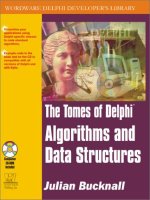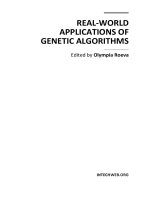Hardware Acceleration of EDA Algorithms- P1 ppsx
Bạn đang xem bản rút gọn của tài liệu. Xem và tải ngay bản đầy đủ của tài liệu tại đây (169.4 KB, 20 trang )
Hardware Acceleration of EDA Algorithms
Kanupriya Gulati · Sunil P. Khatri
Hardware Acceleration
of EDA Algorithms
Custom ICs, FPGAs and GPUs
123
Kanupriya Gulati
109 Branchwood Trl
Coppell TX 75019
USA
Sunil P. Khatri
Department of Electrical & Computer
Engineering
Texas A & M University
College Station TX
77843-3128
214 Zachry Engineering Center
USA
ISBN 978-1-4419-0943-5 e-ISBN 978-1-4419-0944-2
DOI 10.1007/978-1-4419-0944-2
Springer New York Dordrecht Heidelberg London
Library of Congress Control Number: 2010920238
c
Springer Science+Business Media, LLC 2010
All rights reserved. This work may not be translated or copied in whole or in part without the written
permission of the publisher (Springer Science+Business Media, LLC, 233 Spring Street, New York,
NY 10013, USA), except for brief excerpts in connection with reviews or scholarly analysis. Use in
connection with any form of information storage and retrieval, electronic adaptation, computer
software, or by similar or dissimilar methodology now known or hereafter developed is forbidden.
The use in this publication of trade names, trademarks, service marks, and similar terms, even if
they are not identified as such, is not to be taken as an expression of opinion as to whether or not
they are subject to proprietary rights.
Printed on acid-free paper
Springer is part of Springer Science+Business Media (www.springer.com)
To our parents and our teachers
Foreword
Single-threaded software applications have ceased to see significant gains in per-
formance on a general-purpose CPU, even with further scaling in very large scale
integration (VLSI) technology. This is a significant problem for electronic design
automation (EDA) applications, since the design complexity of VLSI integrated
circuits (ICs) is continuously growing. In this research monograph, we evaluate
custom ICs, field-programmable gate arrays (FPGAs), and graphics processors as
platforms for accelerating EDA algorithms, instead of the general-purpose single-
threaded CPU. We study applications which are used in key time-consuming steps
of the VLSI design flow. Further, these applications also have different degrees of
inherent parallelism in them. We study both control-dominated EDA applications
and control plus data parallel EDA applications. We accelerate these applications
on these different hardware platforms. We also present an automated approach for
accelerating certain uniprocessor applications on a graphics processor.
This monograph compares custom ICs, FPGAs, and graphics processing units
(GPUs) as potential platforms to accelerate EDA algorithms. It also provides details
of the programming model used for interfacing with the GPUs. As an example of a
control-dominated EDA problem, Boolean satisfiability (SAT) is accelerated using
the following hardware implementations: (i) a custom IC-based hardware approach
in which the traversal of the implication graph and conflict clause generation are
performed in hardware, in parallel, (ii) an FPGA-based hardware approach to accel-
erate SAT in which the entire SAT search algorithm is implemented in the FPGA,
and (iii) a complete SAT approach which employs a new GPU-enhanced variable
ordering heuristic.
In this monograph, several EDA problems with varying degrees of control and
data parallelisms are accelerated using a general-purpose graphics processor. In par-
ticular we accelerate Monte Carlo based statistical static timing analysis, device
model evaluation (for accelerating circuit simulation), fault simulation, and fault
table generation on a graphics processor, with speedups of up to 800×. Addition-
ally, an automated approach is presented that accelerates (on a graphics proces-
sor) uniprocessor code that is executed multiple times on independent data sets
in an application. The key idea here is to partition the software into kernels in an
automated fashion, such that multiple independent instances of these kernels, when
vii
viii Foreword
executed in parallel on the GPU, can maximally benefit from the GPU’s hardware
resources.
We hope that this monograph can serve as a valuable reference to individuals
interested in exploring alternative hardware platforms and to those interested in
accelerating various EDA applications by harnessing the parallelism in these plat-
forms.
College Station, TX Kanupriya Gulati
College Station, TX Sunil P. Khatri
October 2009
Preface
In recent times, serial software applications have no longer enjoyed significant
gains in performance with process scaling, since microprocessor performance gains
have been hampered due to increases in power and manufacturability issues, which
accompany scaling. With the continuous growth of IC design complexities, this
problem is particularly significant for EDA applications. In this research mono-
graph, we evaluate the feasibility of hardware platforms such as custom ICs, FPGAs,
and graphics processors, for accelerating EDA algorithms. We choose applications
which contribute significantly to the total runtime of the VLSI design flow and
which have varied degrees of inherent parallelism in them. We study the acceler-
ation of such algorithms on these alternative platforms. We also present an auto-
mated approach to accelerate certain specific types of uniprocessor subroutines on
the GPU.
This research monograph consists of four parts. The alternative hardware plat-
forms, along with the details of the programming model used for interfacing with
the graphics processing units, are discussed in the first part of this monograph.
The s econd part of this monograph studies the acceleration of an algorithm in
the control-dominated category, namely Boolean satisfiability (SAT). The third part
studies the acceleration of some algorithms in the control plus data parallel cate-
gory, namely Monte Carlo based statistical static timing analysis, circuit simulation,
fault simulation and fault table generation. In the fourth part of the monograph, we
present the automated approach to generate GPU code to accelerate certain software
subroutines.
Book Outline
This research monograph is organized into four parts. In Part I of this research
monograph, we discuss alternative hardware platforms. We also provide details of
the programming model used for interfacing with the graphics processor. In Chap-
ter 2, we compare and contrast the hardware platforms that are considered in this
monograph. In particular, we discuss custom-designed ICs, reconfigurable architec-
tures such as FPGAs, and streaming processors such as graphics processing units
ix
x Preface
(GPUs). This comparison is performed over various criteria such as architecture,
expected performance, programming model and environment, scalability, time to
market, security, and cost of hardware. In Chapter 3, we describe the programming
environment used for interfacing with the GPUs.
In Part II of this monograph we present hardware implementations of a control-
dominated EDA problem, namely Boolean satisfiability (SAT). We present
approaches to accelerate SAT using each of the three hardware platforms under
consideration. In Chapter 4, we present a custom IC-based hardware approach to
accelerate SAT. In this approach, the traversal of the implication graph and con-
flict clause generation are performed in hardware, in parallel. Further, we propose a
hardware approach to extract the minimum unsatisfiable core for any unsatisfiable
formula. In Chapter 5, we discuss an FPGA-based hardware approach to accelerate
SAT. In this approach, we store the clauses in the FPGA slices. In order to solve
large SAT instances, we partition the instance into ‘bins,’ each of which can fit in
the FPGA. The solution of SAT clauses of any bin is performed in parallel. Our
approach also handles (in hardware) the fact that the original SAT instance is par-
titioned into bins. In Chapter 6, we present a SAT approach which employs a new
GPU-enhanced variable ordering heuristic. In this approach, we augment a CPU-
based complete procedure (MiniSAT), with a GPU-based approximate procedure
(survey propagation). In this manner, the complete procedure benefits from the high
parallelism of the GPU.
In Part III of this book, we study the acceleration of several EDA problems,
with varying amounts of control and data parallelism, on a GPU. In Chapter 7, we
exploit the parallelism in Monte Carlo based statistical static timing analysis and
accelerate it on a graphics processor. In this approach, we map the Monte Carlo
based SSTA computations to the large number of threads that can be computed in
parallel on a GPU. Our approach performs multiple delay simulations of a s ingle
gate in parallel and further benefits from a parallel implementation of the Mersenne
Twister pseudo-random number generator on the GPU, followed by Box–Muller
transformations (also implemented on the GPU). In Chapter 8, we study the accel-
eration of fault simulation on a GPU. Fault simulation is inherently parallelizable
and requires a large number of gate evaluations to be performed for each gate in
a design. The large number of threads that can be computed in parallel on a GPU
can be employed to perform a large number of these gate evaluations in parallel. We
implement a pattern and fault parallel fault simulator, which fault-simulates a circuit
in a levelized fashion. We ensure that all threads of the GPU compute identical
instructions, but on different data. We study the generation of a fault table using a
GPU in Chapter 9. We employ a pattern parallel approach, which utilizes both bit
parallelism and thread-level parallelism. In Chapter 10, we explore the GPU-based
acceleration of the model card evaluation of a circuit simulator. Our resulting code
is integrated into a commercial fast SPICE tool, and the overall speedup obtained
is measured. With careful engineering, we maximally harness the GPU’s immense
memory bandwidth and high computational power.
In Part IV of this book, we present an automated approach to accelerate unipro-
cessor subroutines which are required to be executed multiple times within an
Preface xi
application, on independent data sets. The target hardware platform is a general-
purpose graphics platform. The key idea here is to partition the subroutine into
kernels in an automated fashion, such that multiple instances of these kernels, when
executed in parallel on the GPU, can maximally benefit from the GPU’s hardware
resources. This approach is detailed in Chapter 11.
The approaches presented in this monograph collectively aim to contribute
toward enabling the VLSI CAD community to accelerate EDA algorithms on dif-
ferent hardware platforms.
College Station, TX Kanupriya Gulati
College Station, TX Sunil P. Khatri
October 2009
Acknowledgments
The work presented in this research monograph would not have been possible with-
out the tremendous amount of help and encouragement we have received from our
families, friends, and colleagues.
In particular, we are grateful to Mandar Waghmode, who contributed toward the
custom IC-based engine for accelerating Boolean satisfiability; Dr. Srinivas Patil,
Dr. Abhijit Jas, and Suganth Paul, for their assistance on the FPGA-based approach
for accelerating Boolean satisfiability; and Dr. John Croix and Rahm Shastry, who
helped in integrating our GPU-based accelerated code for model card evaluation
into a commercial fast SPICE tool.
We acknowledge the insightful comments of Dr. Peng Li, Dr. Hank Walker,
Dr. Desmond Kirkpatrick, and Dr. Jim Ji. We would also like to thank Intel Cor-
poration, Nascentric Inc., Accelicon Technologies Inc., and NVIDIA Corporation,
for supporting this research through research grants and an NVIDIA fellowship,
respectively.
xiii
Contents
1 Introduction 1
1.1 Hardware Platforms Considered in This Research Monograph . . . . 3
1.2 EDA Algorithms Studied in This Research Monograph . . . . 3
1.2.1 Control-DominatedApplications 4
1.2.2 ControlPlusDataParallelApplications 4
1.3 Automated Approach for GPU-Based Software Acceleration . . . . . 4
1.4 Chapter Summary . . . . . . 4
References 5
Part I Alternative Hardware Platforms
2 Hardware Platforms 9
2.1 Chapter Overview . . . . . . 9
2.2 Introduction 9
2.3 Hardware Platforms Studied in This Research Monograph . 10
2.3.1 CustomICs 10
2.3.2 FPGAs 10
2.3.3 Graphics Processors 10
2.4 General Overview and Architecture . . 11
2.5 Programming Model and Environment 14
2.6 Scalability . . 15
2.7 Design Turn-Around Time . . . 16
2.8 Performance . . . . 16
2.9 CostofHardware 18
2.10 FloatingPointOperations 18
2.11 Security and Real-Time Applications . 19
2.12 Applications 19
2.13 Chapter Summary . . . . . . 20
References 20
xv
xvi Contents
3 GPU Architecture and the CUDA Programming Model 23
3.1 Chapter Overview . . . . . . 23
3.2 Introduction 23
3.3 Hardware Model 24
3.4 Memory Model . 25
3.5 Programming Model . . . . 28
3.6 Chapter Summary . . . . . . 30
References 30
Part II Control-Dominated Category
4 Accelerating Boolean Satisfiability on a Custom IC 33
4.1 Chapter Overview . . . . . . 33
4.2 Introduction 34
4.3 PreviousWork 36
4.4 HardwareArchitecture 37
4.4.1 AbstractOverview 37
4.4.2 HardwareOverview 38
4.4.3 HardwareDetails 39
4.5 An Example of Conflict Clause Generation 50
4.6 Partitioning the CNF Instance 51
4.7 Extraction of the Unsatisfiable Core . . 53
4.8 Experimental Results . . . 54
4.9 Chapter Summary . . . . . . 59
References 59
5 Accelerating Boolean Satisfiability on an FPGA 63
5.1 Chapter Overview . . . . . . 63
5.2 Introduction 64
5.3 PreviousWork 64
5.4 HardwareArchitecture 66
5.4.1 ArchitectureOverview 66
5.5 Solving a CNF Instance Which Is Partitioned into Several Bins . . . 67
5.6 Partitioning the CNF Instance 69
5.7 HardwareDetails 70
5.8 Experimental Results . . . 72
5.8.1 CurrentImplementation 72
5.8.2 Performance Model . 73
5.8.3 Projections 77
5.9 Chapter Summary . . . . . . 80
References 80
Contents xvii
6 Accelerating Boolean Satisfiability on a Graphics Processing Unit 83
6.1 Chapter Overview . . . . . . 83
6.2 Introduction 83
6.3 RelatedPreviousWork 85
6.4 Our Approach . . 87
6.4.1 SurveySATandtheGPU 87
6.4.2 MiniSAT Enhanced with Survey Propagation (MESP) . . . 93
6.5 Experimental Results . . . 96
6.6 Chapter Summary . . . . . . 98
References 98
Part III Control Plus Data Parallel Applications
7 Accelerating Statistical Static Timing Analysis Using Graphics
Processors 105
7.1 Chapter Overview . . . . . . 105
7.2 Introduction 106
7.3 PreviousWork 108
7.4 Our Approach . . 109
7.4.1 StaticTimingAnalysis(STA)ataGate 109
7.4.2 Statistical Static Timing Analysis (SSTA) at a Gate . . . . . . 112
7.5 Experimental Results . . . 113
7.6 Chapter Summary . . . . . . 116
References 116
8 Accelerating Fault Simulation Using Graphics Processors 119
8.1 Chapter Overview . . . . . . 119
8.2 Introduction 119
8.3 PreviousWork 121
8.4 Our Approach . . 122
8.4.1 LogicSimulationataGate 123
8.4.2 FaultInjectionataGate 125
8.4.3 FaultDetectionataGate 126
8.4.4 FaultSimulationofaCircuit 127
8.5 Experimental Results . . . 129
8.6 Chapter Summary . . . . . . 131
References 131
9 Fault Table Generation Using Graphics Processors 133
9.1 Chapter Overview . . . . . . 133
9.2 Introduction 134
9.3 PreviousWork 136
9.4 Our Approach . . 136
xviii Contents
9.4.1 Definitions 137
9.4.2 Algorithms: FSIM∗ andGFTABLE 139
9.5 Experimental Results . . . 146
9.6 Chapter Summary . . . . . . 150
References 151
10 Accelerating Circuit Simulation Using Graphics Processors 153
10.1 Chapter Overview . . . . . . 153
10.2 Introduction 153
10.3 PreviousWork 155
10.4 Our Approach . . 157
10.4.1 Parallelizing BSIM3 Model Computations on a GPU . . . . 158
10.5 Experiments 162
10.6 Chapter Summary . . . . . . 165
References 165
Part IV Automated Generation of GPU Code
11 Automated Approach for Graphics Processor Based Software
Acceleration 169
11.1 Chapter Overview . . . . . . 169
11.2 Introduction 169
11.3 Our Approach . . 171
11.3.1 Problem Definition . . 171
11.3.2 GPU Constraints on the Kernel Generation Engine 172
11.3.3 Automatic Kernel Generation Engine . . . . 173
11.4 Experimental Results . . . 176
11.4.1 Evaluation Methodology . . . . 177
11.5 Chapter Summary . . . . . . 179
References 179
12 Conclusions 181
References 187
Index 189
List of Tables
4.1 Encoding of {reg,reg_bar}bits 41
4.2 Encoding of {lit,lit_bar} and var_implied signals . . . . . 42
4.3 Partitioning and binning results . . . 55
4.4 Comparing against MiniSAT (a BCP-based software SAT solver) . . . . . 57
5.1 Number of bins touched with respect to bin size 76
5.2 LUTdistributionforFPGAdevices 76
5.3 RuntimecomparisonXC4VFX140versusMiniSAT 79
6.1 Comparing MiniSAT with SurveySAT (CPU) and SurveySAT (GPU) . . 94
6.2 ComparingMESPwithMiniSAT 97
7.1 MonteCarlobasedSSTAresults 115
8.1 Encoding of the mask bits . . . 126
8.2 Parallelfaultsimulationresults 130
9.1 Fault table generation results with L =32K 148
9.2 Fault table generation results with L =8K 149
9.3 Fault table generation results with L =16K 150
10.1 Speedup for BSIM3 evaluation . . . 162
10.2 Speedup for circuit simulation 163
11.1 Validation of the automatic kernel generation approach . 178
xix









